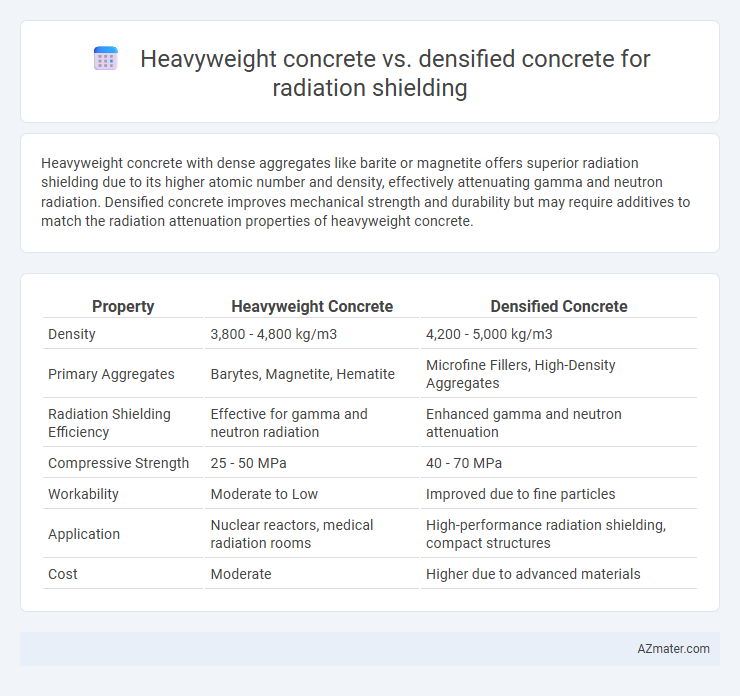Heavyweight concrete with dense aggregates like barite or magnetite offers superior radiation shielding due to its higher atomic number and density, effectively attenuating gamma and neutron radiation. Densified concrete improves mechanical strength and durability but may require additives to match the radiation attenuation properties of heavyweight concrete.
Table of Comparison
| Property | Heavyweight Concrete | Densified Concrete |
|---|---|---|
| Density | 3,800 - 4,800 kg/m3 | 4,200 - 5,000 kg/m3 |
| Primary Aggregates | Barytes, Magnetite, Hematite | Microfine Fillers, High-Density Aggregates |
| Radiation Shielding Efficiency | Effective for gamma and neutron radiation | Enhanced gamma and neutron attenuation |
| Compressive Strength | 25 - 50 MPa | 40 - 70 MPa |
| Workability | Moderate to Low | Improved due to fine particles |
| Application | Nuclear reactors, medical radiation rooms | High-performance radiation shielding, compact structures |
| Cost | Moderate | Higher due to advanced materials |
Introduction to Radiation Shielding Materials
Heavyweight concrete incorporates high-density aggregates such as barite, magnetite, or hematite to achieve superior radiation attenuation properties, making it ideal for shielding nuclear reactors and medical facilities. Densified concrete, enhanced through additives and refined mix design, increases particle packing density to reduce porosity and improve radiation shielding effectiveness. Both materials optimize gamma ray and neutron attenuation, but heavyweight concrete offers greater mass density, whereas densified concrete provides improved mechanical strength and durability.
Overview of Heavyweight Concrete
Heavyweight concrete, incorporating high-density aggregates such as barite, magnetite, or hematite, provides superior radiation shielding by significantly increasing the material's mass per unit volume. Its high density enhances attenuation of gamma rays and neutrons, making it a preferred choice for medical facilities, nuclear power plants, and radiation labs. This type of concrete offers enhanced durability and structural integrity while effectively reducing radiation exposure.
Densified Concrete: Definition and Properties
Densified concrete is a specialized type of concrete formulated with high-density aggregates such as barite, magnetite, or hematite to achieve enhanced radiation shielding properties, surpassing conventional heavyweight concrete. Its increased density, typically ranging from 3,200 to 4,000 kg/m3, significantly improves gamma ray and neutron attenuation, making it ideal for nuclear reactors, medical radiation facilities, and radioactive waste containment. The material's reduced porosity and optimized microstructure enhance both mechanical strength and durability while effectively minimizing radiation exposure.
Key Differences Between Heavyweight and Densified Concrete
Heavyweight concrete incorporates aggregates such as barite, magnetite, or hematite to achieve higher density and superior radiation shielding properties compared to standard concrete, making it ideal for nuclear facilities. Densified concrete primarily relies on optimized particle packing and reduced porosity to enhance density and strength but may not provide the same level of gamma and neutron attenuation as heavyweight concrete. Key differences include heavyweight concrete's reliance on specific high-density aggregates for radiation attenuation versus densified concrete's microstructural improvements focusing on mechanical strength and moderate shielding capabilities.
Radiation Attenuation Mechanisms
Heavyweight concrete achieves superior radiation attenuation through its high-density aggregates, such as barite or magnetite, which increase the mass per unit volume to effectively absorb gamma rays and neutrons. Densified concrete enhances radiation shielding by reducing porosity and increasing the material's homogeneity, which minimizes voids that could allow radiation penetration. Both materials utilize mechanisms of photon attenuation, including photoelectric absorption and Compton scattering, but heavyweight concrete's higher atomic number elements provide a greater attenuation coefficient for ionizing radiation.
Comparative Shielding Effectiveness
Heavyweight concrete, typically composed of aggregates like barite or magnetite, offers superior gamma radiation attenuation due to its higher density, making it highly effective for radiation shielding in nuclear facilities. Densified concrete utilizes fine particles and optimized compaction to reduce porosity, enhancing neutron radiation shielding by increasing hydrogen content and improving structural integrity. Comparative studies reveal heavyweight concrete excels in gamma attenuation, while densified concrete provides better neutron moderation, suggesting a combined or application-specific approach for optimal radiation protection.
Mechanical and Structural Considerations
Heavyweight concrete, with its high-density aggregates like barite or magnetite, provides superior radiation shielding while maintaining adequate compressive strength for structural applications. Densified concrete enhances mechanical properties through particle packing optimization, resulting in increased strength and reduced porosity, which improves durability under radiation exposure. Structural considerations favor heavyweight concrete for its proven load-bearing capacity, whereas densified concrete offers potential for thinner shielding barriers without compromising mechanical integrity.
Cost and Construction Factors
Heavyweight concrete, incorporating aggregates like barites or magnetite, offers effective radiation shielding but often results in higher material costs and extended curing times compared to densified concrete. Densified concrete achieves radiation protection through optimized mix designs and compaction techniques, reducing porosity and improving strength, which can lower construction time and labor expenses. Balancing the higher initial costs of heavyweight aggregates against the efficiency gains in densified concrete construction is critical for budget-sensitive radiation shielding projects.
Long-term Durability and Maintenance
Heavyweight concrete, often incorporating barite or magnetite aggregates, provides excellent radiation shielding with proven long-term durability, exhibiting minimal degradation under sustained exposure to radiation and environmental stressors. Densified concrete, characterized by its reduced porosity and enhanced density through mechanical or chemical means, offers superior resistance to radiation-induced microcracking and requires less frequent maintenance due to lower permeability and improved structural integrity. Both materials ensure effective radiation protection, but densified concrete may deliver extended service life and reduced upkeep costs in high-radiation environments.
Best Applications: Selecting the Right Concrete for Radiation Protection
Heavyweight concrete, dense with aggregates like magnetite or hematite, is ideal for gamma and X-ray shielding in medical and nuclear facilities due to its superior density and attenuation properties. Densified concrete, characterized by optimized particle packing and reduced porosity, excels in neutron radiation shielding where hydrogen-rich materials are integrated for enhanced neutron absorption. Selecting the right concrete depends on the specific radiation type and energy spectrum; heavyweight concrete is preferred for high-energy photon protection, while densified concrete suits mixed radiation fields requiring neutron moderation.

Infographic: Heavyweight concrete vs Densified concrete for Radiation shielding
 azmater.com
azmater.com